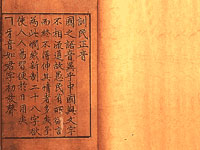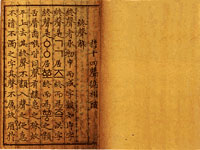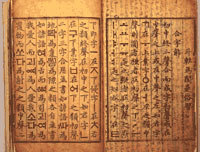Memory of the World
Memory of the World- Republic of Korea
-
Hunminjeongeum Manuscript
Proper Sound to Instruct the People Korea's official script is Hangeul, the unique Korean alphabet. This name, a compound of han, meaning "the Korean people" or "great" and geul, meaning "letters," was given to it early in the 20th century. The creator of hangeul was King Sejong the Great (reigned 1418-1450), the fourth king of the Joseon Dynasty. Sejong was concerned that Chinese characters, until that time used to write Korean, were a writing system for representing Chinese, a language completely different in structure from Korean, and were therefore hard for Koreans to learn and use. 
In the twelfth lunar month of 1443, he completed development of a writing system suitable for representing Korean, which he called Hunminjeongeum, "Proper sounds to instruct the people." Hunminjeongeum was an alphabet formed of 28 letters. Today's hangeul uses only 24 of these, having dropped four. This orthography not only represents the Korean language perfectly but also is easy to learn and use. It is recognized as being both original and scientific. Sejong himself wrote a preface clarifying the origin and the purpose of the new alphabet and giving brief examples and explanations of each of its letters, while he had the scholars of the Jiphyeonjeon, or "Hall of Worthies," give detailed explanations and examples of them. The resulting work was published in the ninth lunar month of 1446, and the new alphabet was widely made known to the public. The work's title was the same as the then name of the alphabet, Hunminjeongeum. The recently discovered complete edition is known as the Haerye Edition of Hunminjeongeum (Haerye referring to the explanations and examples of the Jiphyeonjeon scholars, which were missing in the previously known editions). 
The extract publication date is not clear. But in the Annals of King Sejong, the official record of his reign, it is noted that the book was published in the ninth month of 1446, and the scholar Jeong In-ji's so, or “postface," which appears in the volume, was written in the first ten days of the ninth lunar month of 1446, so we can judge that it was published by the tenth day of that month. This date, converted to the solar date October 9, has been designated Hangeul Day, a national holiday. 
The Haerye Edition of Hunminjeongeum was published about 550 years ago, and was thought to have been long lost, but a copy was found by chance in 1940 in an old house in Andong, Gyeongsangbuk-do, and is presently preserved in Kansong Art Museum in Seoul. In 1958 the government designated it a national treasure and instituted a strict policy for its conservation.
As mentioned above, this book consists of two parts. Part 1 is the main text written by Sejong himself. The contents of the main text are the seomun or preface, which explains his purpose in creating the new letters, and the longer section which presents and explains the 28 new letters, 17 initial (consonant) sounds and 11 medial (vowel) sounds, and the way they are combined to represent Korean syllables. Part 2, written by the scholars of the Hall of Worthies on Sejong's order, consists of commentaries on the main text.
There are 6 chapters : "An Explanation of the Design of the Letters," which expounds the principles by which the new letters were made, "An Explanation of the Initials," which presents the 17 consonants which appear in syllable-initial position, "An Explanation of the Medials," which presents the 11 vowels, "An Explanation of the Finals," which presents the consonants appearing in syllable-final position," "An Explanation of the Combining the Letters," which demonstrates how the initials, medials, and finals are assembled to form a syllable, and "Examples of the Uses of the Letters," which shows Korean words written in the new letters. At the end of the volume is Jeong In-ji's postface, which concisely describes the greatness of the creation of the new letters and the circumstances of the writing of the book. The main text is four leaves and the commentaries 29 leaves, making only 33 leaves in all, but the theory is systematic and the description scientific. In particular the explanation of the principles by which the letters were made and of no use of the letters is highly regarded today by the linguists of the world.Many people have tried to make letters to try to represent their languages. This has been one of the important themes of world history. The world's major orthographies gradually took form and came into use over long periods of time. Moreover, most of them were changed through use over time. The development of Korea's hangeul is a unique example of a few people, in a short time, without any direct influence from any already existing orthography, inventing a new writing system for a language which enabled mass literacy, one which eventually would become its official script. Moreover, the publishing of a book on a new alphabet is not only something that had never happened before Hunminjeongeum was published in 1446 but something that has not happened since. 
The publication of such a unique book with such excellent content in 1446 is without doubt a historic event. How fortunate it is that even one copy of this work has been handed down to us just as it was. These are the reasons why Hunminjeongeum is not only a Korean national treasure but an achievement which must be preserved forever as a legacy of world culture.



 >
>